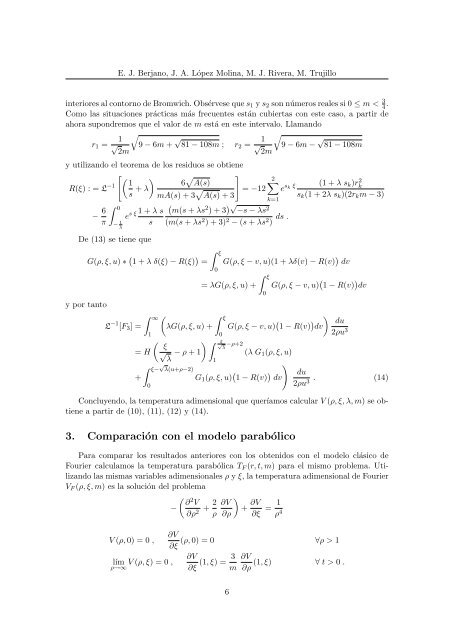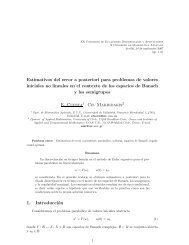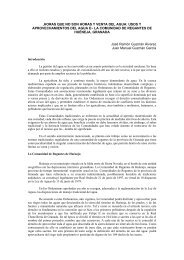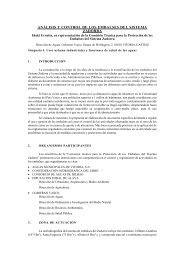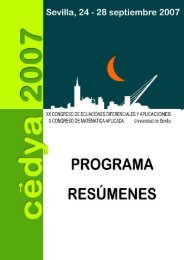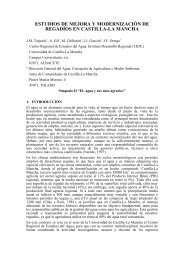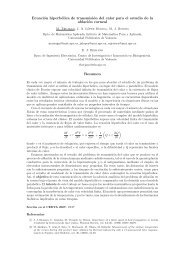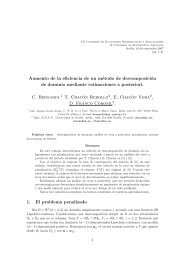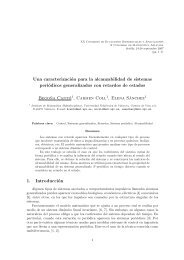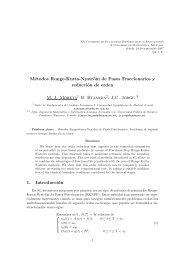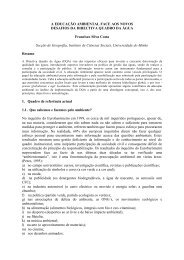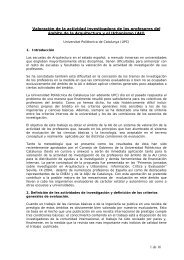Ecuación hiperbólica de transmisión del calor para el estudio de la ...
Ecuación hiperbólica de transmisión del calor para el estudio de la ...
Ecuación hiperbólica de transmisión del calor para el estudio de la ...
You also want an ePaper? Increase the reach of your titles
YUMPU automatically turns print PDFs into web optimized ePapers that Google loves.
E. J. Berjano, J. A. López Molina, M. J. Rivera, M. Trujillo<br />
interiores al contorno <strong>de</strong> Bromwich. Obsérvese que s1 y s2 son números reales si 0 ≤ m < 3<br />
4 .<br />
Como <strong>la</strong>s situaciones prácticas más frecuentes están cubiertas con este caso, a partir <strong>de</strong><br />
ahora supondremos que <strong>el</strong> valor <strong>de</strong> m está en este intervalo. L<strong>la</strong>mando<br />
r1 = 1<br />
√ 2m<br />
<br />
9 − 6m + √ 81 − 108m ; r2 = 1<br />
√ 2m<br />
<br />
9 − 6m − √ 81 − 108m<br />
y utilizando <strong>el</strong> teorema <strong>de</strong> los residuos se obtiene<br />
R(ξ) : = L −1<br />
1 <br />
6<br />
+ λ<br />
s A(s)<br />
mA(s) + 3 <br />
2<br />
= −12 e<br />
A(s) + 3<br />
k=1<br />
sk ξ (1 + λ sk)r2 k<br />
sk(1 + 2λ sk)(2rkm − 3)<br />
− 6<br />
0<br />
π − 1<br />
√<br />
s ξ 1 + λ s m(s + λs2 ) + 3 −s − λs2 e<br />
s (m(s + λs<br />
λ<br />
2 ) + 3) 2 − (s + λs2 ds .<br />
)<br />
De (13) se tiene que<br />
G(ρ, ξ, u) ∗ 1 + λ δ(ξ) − R(ξ) ξ<br />
= G(ρ, ξ − v, u)(1 + λδ(v) − R(v) dv<br />
y por tanto<br />
L −1 ∞<br />
[F3] =<br />
1<br />
= H<br />
+<br />
<br />
ξ<br />
λG(ρ, ξ, u) +<br />
ξ<br />
√λ − ρ + 1<br />
ξ− √ λ(u+ρ−2)<br />
0<br />
0<br />
ξ<br />
= λG(ρ, ξ, u) + G(ρ, ξ − v, u) 1 − R(v) dv<br />
0<br />
ξ<br />
√λ −ρ+2<br />
1<br />
0<br />
G(ρ, ξ − v, u) 1 − R(v) <br />
du<br />
dv<br />
2ρu3 G1(ρ, ξ, u) 1 − R(v) dv<br />
(λ G1(ρ, ξ, u)<br />
<br />
du<br />
. (14)<br />
2ρu3 Concluyendo, <strong>la</strong> temperatura adimensional que queríamos calcu<strong>la</strong>r V (ρ, ξ, λ, m) se obtiene<br />
a partir <strong>de</strong> (10), (11), (12) y (14).<br />
3. Com<strong>para</strong>ción con <strong>el</strong> mo<strong>de</strong>lo <strong>para</strong>bólico<br />
Para com<strong>para</strong>r los resultados anteriores con los obtenidos con <strong>el</strong> mo<strong>de</strong>lo clásico <strong>de</strong><br />
Fourier calcu<strong>la</strong>mos <strong>la</strong> temperatura <strong>para</strong>bólica TF (r, t, m) <strong>para</strong> <strong>el</strong> mismo problema. Utilizando<br />
<strong>la</strong>s mismas variables adimensionales ρ y ξ, <strong>la</strong> temperatura adimensional <strong>de</strong> Fourier<br />
VF (ρ, ξ, m) es <strong>la</strong> solución <strong>de</strong>l problema<br />
V (ρ, 0) = 0 ,<br />
−<br />
lím V (ρ, ξ) = 0 ,<br />
ρ→∞<br />
<br />
∂2V 2<br />
+<br />
∂ρ2 ρ<br />
<br />
∂V<br />
+<br />
∂ρ<br />
∂V<br />
∂ξ<br />
= 1<br />
ρ 4<br />
∂V<br />
(ρ, 0) = 0 ∀ρ > 1<br />
∂ξ<br />
∂V 3<br />
(1, ξ) =<br />
∂ξ m<br />
6<br />
∂V<br />
(1, ξ) ∀ t > 0 .<br />
∂ρ


